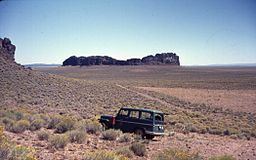Last eruption About 50,000 years ago | Geology Maar | |
 | ||
Location Lake County, Oregon, USA Elevation 4,331–5,630 ft (1,320–1,716 m) Age About 50,000 to 100,000 years old Similar Hole‑in‑the‑Ground, Big Hole, Four Craters Lava Field, Fort Rock, Newberry Volcano | ||
The Fort Rock-Christmas Lake Valley Basin is the basin of a former inland sea that existed in that region from Pliocene through late Pleistocene time. The Fort Rock basin maar field includes over 30 hydrovolcanic landforms spread over an area of 1,500 square miles (4,000 km2).
Contents
Map of Fort Rock Basin, Oregon 97638, USA
Moffitt Butte
Moffitt Butte is a dissected basaltic tuff ring, 4,600 feet (1,400 m) in diameter and 400 feet (120 m) high. Moffitt Butte is not associated with a lake basin, as is the case for Fort Rock and Hole-in-the-Ground, but rising magma probably encountered permeable aquifers beneath the cone. A line of tuff rings between Moffitt Butte and the Fort Rock-Christmas Lake Valley Basin are located roughly along what would have been an early drainage route between the Fort Rock Basin and the La Pine Basin. The crater floor of Moffitt Butte is about 260 feet (80 m) above the surrounding plain. A smaller vent and small tuff ring, 1,700 feet (520 m) in diameter, are located on Moffitt Butte's southwestern flank. The crater of the smaller vent is filled with lava that issued from a dike on its northwest edge.
Table Rock
Table Rock is an erosional remnant of a tuff cone, which at present is a symmetrical cone about 5,020 feet (1,530 m) in diameter at the base, tapering to a diameter of about 1,180 feet (360 m) at a height of 1,180 feet (360 m) above the surrounding plain. The cone is capped with flat-lying basalt which once filled the crater, but erosion has modified the original cone, exposing the once ponded basalt lava lake. Dikes extend north and south of the crater's lava lake. On the lower flanks of the cone, the rocks are mostly palagonite lapilli-tuff. Near the summit, the uppermost palagonites are overlain by massive cinders and bombs from fire-fountaining that preceded the filling of the crater with lava.
